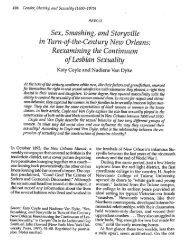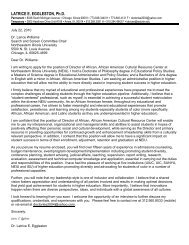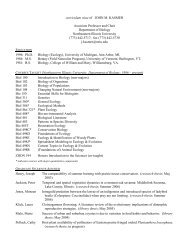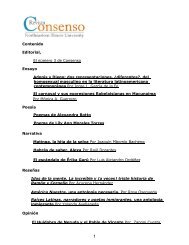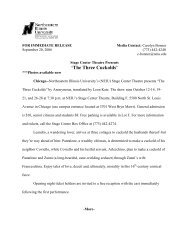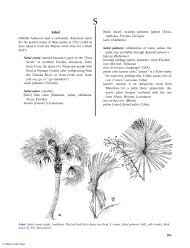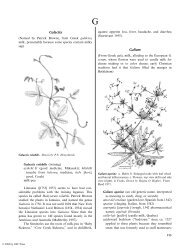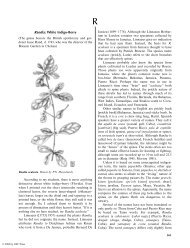Herba Cana - Northeastern Illinois University
Herba Cana - Northeastern Illinois University
Herba Cana - Northeastern Illinois University
You also want an ePaper? Increase the reach of your titles
YUMPU automatically turns print PDFs into web optimized ePapers that Google loves.
© 2004 by CRC Press<br />
548 Florida Ethnobotany<br />
by that common name in English, French (café<br />
marron, Guadeloupe, Martinique), and Spanish in<br />
the Caribbean (café cimarrón, wild coffee, Dominican<br />
Republic), and Mexico (kapee ts’ohool, coffee herb,<br />
Huastec, San Luis Potosí). There is an indirect<br />
reference to the place of coffee origin in Africa with<br />
palo moro (Moorish tree, Puerto Rico).<br />
Although Psychotria is compared with coffee, it is<br />
not used as a beverage. Several people have told me<br />
they tried using Psychotria seeds as a substitute<br />
‘‘coffee,’’ and got only bad taste and terrible headaches<br />
from the mixture. However, these plants are<br />
surely rich in tannins because mashed leaves are used<br />
as a hemostat in Cuba (Roig 1945) and Puerto Rico<br />
(Meléndez 1989). People in Barbados use a leaf<br />
decoction as a febrifuge, as a remedy for colds, and<br />
to treat stomach ailments. Leaves are combined with<br />
other plants as ‘‘bush tea’’ (Goodding 1940 /1942),<br />
which is used to treat a number of maladies. In keeping<br />
with their multiple common names, the Huastecs of<br />
Mexico have the most varied uses (Alcorn 1984). Like<br />
Barbadians, the Huastecs use it to treat respiratory<br />
problems, especially asthma. Other uses include application<br />
to local swellings, such as swollen feet, and<br />
erysipelas, sores, boils, tumors, and skin fungus. Does<br />
bois laitelle (milk trees, Haiti) mean they use it with<br />
milk?<br />
Before Coffea was introduced into the New World,<br />
people here used other names for the Psychotria. The<br />
only indigenous name from within Florida is for P.<br />
sulzneri. This hammock shrub is known by the<br />
Seminoles as atópâ:bî (dogwood replica, Mikasuki).<br />
According to Sturtevant’s (1955) informants, the plant<br />
was ‘‘useless.’’ However, that name was derived from<br />
Creek vtvphv [atápha] for dogwood (Cornus), and that<br />
comparison with another species suggests a loss of<br />
information (see Cornus). Every species of Cornus in<br />
North America was used by people of essentially every<br />
culture (Moerman 1998).<br />
Florida’s other ‘‘wild coffee’’ (Florida, Bahamas,<br />
Puerto Rico), P. nervosa, has a diversity of names<br />
outside the state. Among those names is ipecacuana<br />
ondulada mayor (big ipecacuanha with undulate<br />
leaves) in Cuba (Roig 1945). That name was given<br />
because the roots of P. nervosa were used as an emetic<br />
as were those in the real ipecacuanha (P. ipecacuanha).<br />
The comparison is instructive, because ipecacauanha<br />
has a long history.<br />
Between 1570 and 1600, the Portuguese priest<br />
Manoel Tristão was in Brazil where he learned that the<br />
Tupí people used the roots of a plant for treating<br />
dysentery. When he returned to Europe, he told more<br />
people about the plant, and French physicians finally<br />
made it available in 1672 (Burkill 1966). We get our<br />
English name ipecacuanha from the Tupí-speakers in<br />
South America who called their medicinal plant<br />
ipega’kwai (duck’s penis) or ipe-kaa-guéne (creeping<br />
plant causing vomiting). The Florida plants have no<br />
such imaginative names.<br />
The only name other than ‘‘wild coffee’’ found in<br />
Florida is Seminole balsamo, given by Morton (1981).<br />
Since she gives no source for the name and it has not<br />
been found elsewhere, the origin remains a mystery.<br />
There is documentation for the name bálsamo in<br />
Puerto Rico (Liogier and Martorell 1982, Meléndez<br />
1989). Literally translated, the word means ‘‘balsam.’’<br />
The probable sense of its use for ‘‘Seminole balsamo’’<br />
is the now archaic meaning of ‘‘soothing.’’ Etymologically,<br />
the word in Spanish and English has been<br />
equivalent to ‘‘balm,’’ both having been derived from<br />
Latin balsamum. The very name itself suggests a long<br />
medical history*/unless Morton invented the name.<br />
Some of the other designations indicating use as a<br />
medicine are kidney bush (Caymans) and St. John’s<br />
bush (Barbados). While perhaps not exactly ‘‘medical,’’<br />
the name strong back (Caymans) suggests<br />
enhanced stamina. Since the name implies two distinct<br />
applications of strength, it was perhaps an important<br />
plant. The interpretation most often given for such<br />
names is improved sexual stamina. However, there was<br />
an equally valuable application. Since our species<br />
became bipedal, we have suffered from innumerable<br />
back problems. In addition, as the name is endemic to<br />
the Virgin Islands where the population is largely<br />
derived from slaves, it takes on added meaning.<br />
Individuals who could not do their share of work<br />
during slaving times were not likely to survive long.<br />
Medicines to ‘‘soothe’’ aching backs would have been<br />
at a premium.<br />
Other names show different perspectives. The<br />
names penda (dangler, Dominican Republic) and<br />
tapa camino (path coverer, Cuba) are surely related<br />
to the locations where these shrubs grow and are<br />
descriptive of their life-forms. Plateado (folded or<br />
plaited, Cuba) is a literal equivalent of the specific<br />
name of the technical synonym Psychotria undata.<br />
That name was proposed by Nicolaus von Jacquin in<br />
his book of 1798, Plantarum Rariorum Horti Caesarei<br />
Schoenbrunnensis, and he too was taken with the<br />
undulating pattern of the living leaves. For some<br />
reason not understood, the plant is called huesito<br />
[husito] (little bone) in Panama. If that were an<br />
isolated case, it would be one thing, but that word is<br />
applied to several Mexican species. None of the uses<br />
suggests a bone medicine, so perhaps the name refers<br />
to the wood.<br />
Mayans call this shrub ya’ax-k’anan [anal, anal<br />
xiv, sacxanal, canaan] (ya’ax, green, k’anan, necessary,<br />
Yucatán), which is their same designation for Hamelia<br />
patens. Both plants are important in Mayan religious





